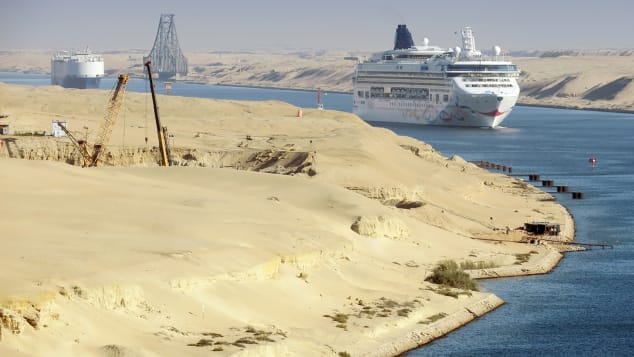Meet here the best suites to travel on a cruise 1:38
(CNN) --
Navigating a colossal ship isn't easy under any circumstances, but some routes -- like the narrow, sandstorm-prone Suez Canal, which was infamous last year after a container ship blocked it -- or the windy waterways of Alaska, surrounded by glaciers, are especially difficult.
Andy Winbow, a master seaman who has steered ships around the world, tells CNN Travel that the most difficult routes are often characterized by "adverse weather conditions, lack of room to maneuver due to natural hazards, and lack of aid to navigation".
These factors affect any ship, but multi-deck cruise ships can be more affected due to their sheer volume.
"The higher the boat, the stronger the wind," says David Pembridge.
Pembridge is a retired cruise ship captain who worked for decades on P&O Cruises and Princess Cruises ships.
When tall ships are buffeted by the wind, they are prone to skidding, a term used to describe when a ship is pulled sideways.
To counteract this effect, the ship has to be steered at an angle.
This maneuver is especially complicated when crossing a waterway such as the Suez Canal or the Panama Canal.
In these narrow channels, ships must also avoid hitting the sides of the channel.
advertising
"If they cross it at high speed, they cause erosion of the banks and drag part of the sand from the sides towards the center of the channel, which is not good because it makes it less deep, which causes a drop in level", Pembridge explains.
A cruise ship sails through the Panama Canal on April 23, 2022.
Credit: Luis Acosta/AFP/AFP via Getty Images
Although the Suez Canal and the Panama Canal have some common features, there are also key differences between the Egyptian waterway and the South American canal.
While the Panama Canal is largely surrounded by forest and vegetation, the Suez Canal is flanked by desert, which means there is the potential for poor visibility caused by sandstorms.
And while the 120-mile Suez Canal is virtually straight, the 50-mile Panama Canal "meanders through islands," as Pembridge puts it, and this topography adds an extra level to the challenge.
"It's a different kind of difficulty, but it still requires quite intense concentration," explains Pembridge.
Ships passing through the Panama Canal must also pass through three different locks.
In recent years, the locks have been enlarged to better accommodate larger ships, but when Pembridge used the route regularly, his ship was separated from the sides of the lock by just a couple of meters.
In Panama, mechanical locomotives also help pull cruise ships through the locks, while on the particularly narrow sections of the Suez, tugboats help guide the larger ships.
"It's usually a long day for the crew on board, because you start and don't stop until you get through the other end," says Pembridge of passing through both channels.
The role of the pilot
Cruise ships are assisted in the Suez Canal by local marine experts, called marine pilots.
Credit: Soeren Stache/picture-alliance/dpa/AP
All ships operating in the Suez and Panama Canals are assisted by local sailors.
These sailors, known as marine pilots, board the ship at the beginning of the channel and work together with the crew on board to ensure safe passage.
Both the Suez and Panama Canals are "compulsory pilotage zones," meaning pilots are not optional, but are required by law.
Pembridge suggests that the working relationship between pilots and captains is not always without its difficulties.
"That's one of the helps and one of the hindrances, sometimes, depending on the level of competition and the personalities involved," he says.
"The pilot must legally direct the direction and speed of the ship. But at the same time, the captain of the ship always has the responsibility for the safe navigation of the ship and that cannot be delegated to the pilot."
In some areas, the pilot's role is less crucial and is not necessarily a legal requirement.
But in the most difficult ports and waterways, like Suez and Panama, or the waterways around Alaska, their role is essential.
Captain John Herring was a research vessel captain before becoming a marine pilot in Southeast Alaska.
Herring tells CNN Travel that there are two main reasons why pilots must be on board ships in certain areas.
"First, we bring local knowledge about route hazards, tides and currents, weather, concentrations of marine life and much more," he explains.
"Second, by being independent of the ship, we provide objective decision-making that is not subject to the economic pressures of the ship's schedule. Captains are experts on their own ships, and we are experts on Alaskan waters."
A cruise ship sails past the Margerie Glacier in Glacier Bay, Alaska.
Photo: Tim Rue/Bloomberg via Getty Images
Southeast Alaska is a mandatory pilot zone, in part because it is prone to strong winds and currents, and in part because of its marine ecosystem.
"Alaska's coastal waters are blessed with an abundance of marine mammals," says Herring.
"Whale watching is one of the favorite pastimes of passengers, but it requires constant vigilance on the bridge to avoid close encounters."
Similarly, sightings of icebergs and glaciers can be one of the highlights of an Alaskan cruise, but these icy formations can cause difficulties for ships.
"That ice is hard and can damage the hull or the propellers," explains Herring, adding that strong winds and currents make it even more difficult to navigate through icy waters.
In recent years, technology has advanced, making it a little easier to navigate unpredictable routes.
But Herring suggests that pilots remain critical in the age of satellite technology.
"The local pilot can still bring the ship safely to port without the need for GPS," he says.
Water depth and local topography
Chile's fjords and canals, including the Murray Channel in the south of the country, pictured here, can pose a special challenge for ships.
Credit: Wolfgang Kaehler/LightRocket/Getty Images
Ships sailing through Alaska must also contend with varying depths of water.
In shallow water channels, ships have to move slowly to avoid creating a low pressure zone under the ship that can cause it to run aground on the seabed.
"Ships can sink if they're traveling too fast and don't have enough clearance under the keel," explains master seaman Andy Winbow.
Cruise routes through the Norwegian fjords and the fjords and channels of Chile also involve occasional navigating through shallow waters.
Meet the world's most extravagant cruise ship suites
Other cruise routes present problems because their topography is constantly changing.
Pembridge gives the example of the Amazon River, whose sections are sometimes traversed on South American cruises.
"The bottom of the Amazon moves continuously, so an island appears on a nautical chart, and when you get there the island is not there, but has moved to another place," he explains.
"It depends a lot on the pilots, because the local pilots are people who know the river and how it moves."
Urban ports can also pose problems.
Pembridge points to the ports of Amsterdam and Rotterdam in the Netherlands and the German port of Hamburg, as well as Ho Chi Minh City in Vietnam.
To dock in any of these cities, cruise ships must first pass through a narrow channel, and how easy it is depends largely on weather conditions.
Planning and unexpected moments
Pembridge took this photo of one of the Panama Canal locks while at the helm of the P&O Cruises cruise ship MV Aurora.
Credit: David Pembridge
A robust travel plan is essential to navigate smoothly.
Pembridge explains that cruise ship voyage plans are usually drawn up by a junior officer and then approved by the captain.
Plans always consider possible known issues, such as wind, width of the waterway, tides, and surrounding terrain.
"If you're out on the open sea, it's a relatively straightforward briefing: this is the course we intend to take, this is the speed we intend to go. Once you get closer to land, and it gets more complicated, then you start highlighting the dangers. , currents and the likely meteorological effects of anything," says Pembridge.
"And when you get into really confined water, which is what the [Suez and Panama] canals are, then it's a much more intense briefing."
The threat of piracy is another factor taken into account, though Pembridge suggests that's less of an issue than before.
He recalls directing ships through the Gulf of Arden at full speed, turning off lights at night and running drills with passengers.
Captain David Pembridge, who retired in 2020, photographed near Chile's Cape Horn.
Credit: David Pembridge
The weather is also taken into account when planning the trip, but not all the preparation in the world can fully anticipate the unforeseen.
Pembridge recalls a time when he captained a ship sailing from the Falkland Islands to South America.
The wind was expected to be strong, but as night fell, the violent gusts were much stronger than expected.
Throughout the night, Pembridge and his team slowly leaned into the waves to try to counteract the impact of the wind.
When it was day, they saw the magnitude of what they had in their hands.
"They were very, very big waves. And the front of the boat would sink in them and come back up again, it was perfectly safe, but very uncomfortable."
By the time the weather had improved, the ship had drifted some 50 kilometers off course.
The ports had to be reorganized and the voyage replanned.
But Pembridge points out that while ships may encounter unexpected challenges, ships and their managers are often prepared for obstacles.
"Modern cruise ships are well-equipped to deal with almost any challenge that comes their way," says Pembridge.
Cruise ships















